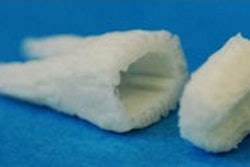Crowns made of porcelain fused to zirconia (PFZ) proved as durable as crowns made from porcelain fused to metal (PFM) in a large study by Noritake Dental Supply.
For the study, which will be presented July 16 at the International Association for Dental Research annual meeting in Barcelona, Spain, U.S. private dentists monitored the performance of 2,635 premolar and molar crowns (1944 PFZ and 691 PFM) fabricated by one dental laboratory over intervals ranging from two to 57 months.
In the PFZ group, one veneering porcelain -- Noritake's Cerabien ZR porcelain -- layered over zirconia cores (CZR, Noritake) was used in combination with three coping systems (Lava, 3M ESPE; Procera, Nobel Biocare; Katana, Noritake). In the PFM group, one veneering porcelain -- Noritake's EX-3 porcelain -- was layered over metal cores with precious alloys (52% gold).
Twenty-two dentists in Greater Boston and adjacent states kept written records of any porcelain chipping, fracture, or loosening.
The mean survival time for posterior crowns was 52 months, with a survival probability of 98.1% for PFZ crowns and 95.8% for PFM crowns, indicating no significant difference between the two modalities for the time interval studied (p = 0.107).
Survival probabilities of individual zirconia coping systems were 97.3% for Lava, 99.5% for Procera, and 99.7% for Katana, which were not significantly different from each other (p = 0.072). For the 1,107 molar and 837 premolar crowns surveyed, mean survival probabilities were not significantly different (p = 0.586) with 97.5% for molar 98.9% for premolar crowns.
Copyright © 2010 DrBicuspid.com



















